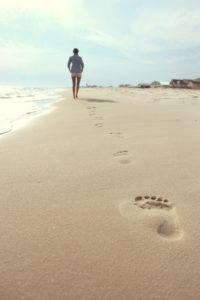Coping | Daily Life | Disability | Events | Voices from Girls with Guts

Photo by Zack Minor on Unsplash.
If you are living with a chronic illness, undergoing medical treatments, or recovering from surgery, establishing an exercise routine can feel like a far-fetched fantasy. While the standard fitness regimens cluttering your social media feeds and local billboards might not work for you right now, there are other ways to make fitness a part of your life.
Social media is full of people sharing their strenuous workout routines. They might make posts about “finishing another 6 mile run” or increasing their bench press weight. It is easy to get consumed with such messages and conclude that running marathons, biking across the country, and lifting hundreds of pounds is the only way to work out. This is not true.
Going for a short daily walk with your dog, hitting the dance floor, or attending a yoga class count as exercise. In fact, Girls with Guts often find that ‘smaller’ activities like this help them build up strength during or after a flare. One GWG reflects on how she started with short walks and gradually increased the length each day. Now, she participates in three dance fitness classes a week!
Try to find an exercise routine that is comfortable and safe for you. You might want to speak with your care team about safe options. Some GWGs, such as Alyssa Zeldenrust, benefit from physical therapy (PT) to build and maintain strength during flares. PT can be especially helpful when it comes to safe core exercises following ostomy or abdominal surgery.
If you are anything like me, the thought of running for the sake of running or lifting weights for the sake of lifting weights leaves you confused and scrambling for excuses.
There is no rule demanding that fitness be boring (please note, I full-heartedly admire those of you who do not find running boring). Many GWG have discovered activities that get them excited about moving. Fellow blogger Alyssa Shapland captures this approach beautifully, when she explains how you “almost need to trick yourself into doing exercise.”
Fortunately, there are dozens of exciting activities that give you a workout without thinking about it. Shapland fell into boxing and loves it! Another GWG is passionate about gymnastics and practices whenever her body allows. Karen enjoys doing jazzercise when it is not too hot. She has found a few incredible instructional videos for free on Youtube!
Having a community rooting for you is also helpful. Sandy suggests finding online exercise groups with a team to keep you motivated. She just had APR surgery in February, but finds that her energy is through the roof. Her recovery and ostomy only limits her with a few core exercises. Alyssa also lauds the benefit of connections when it comes to exercise. She enjoys attending exercise classes and walking with friends.
Research shows that goal-setting is a highly effective motivator. Goals encourage us to push ourselves to meet new standards.
I am going to pause for a second here because myths surrounding goal-setting are similar to those about exercise. Your goal does not need to be completing the New York City Marathon or a Ninja Warrior Challenge. You could simply aim to go for a walk each day or strive for 10,000 steps.
Once you decide on a clear goal, you can start working on it in gradual steps. Remember to go at your own pace and be flexible. As we all know too well, life happens. Be prepared to adjust your goal if necessary.
When setting and working towards fitness goals, it is critical to listen to your body and your doctor. Pushing yourself too much during a flare or recovery period can do more damage than good.

Photo by Natalie Pedigo on Unsplash.
Celebrate your effort regardless of the end result. Life is messy and unpredictable. There are so many factors beyond your control that can prevent you from reaching your goal. Do not punish yourself for falling short when you have tried. Instead, pat yourself on the back for fighting so hard against all odds.
Read about how other Girls with Guts stay active!
Navigating Athletics With Crohn’s Disease
